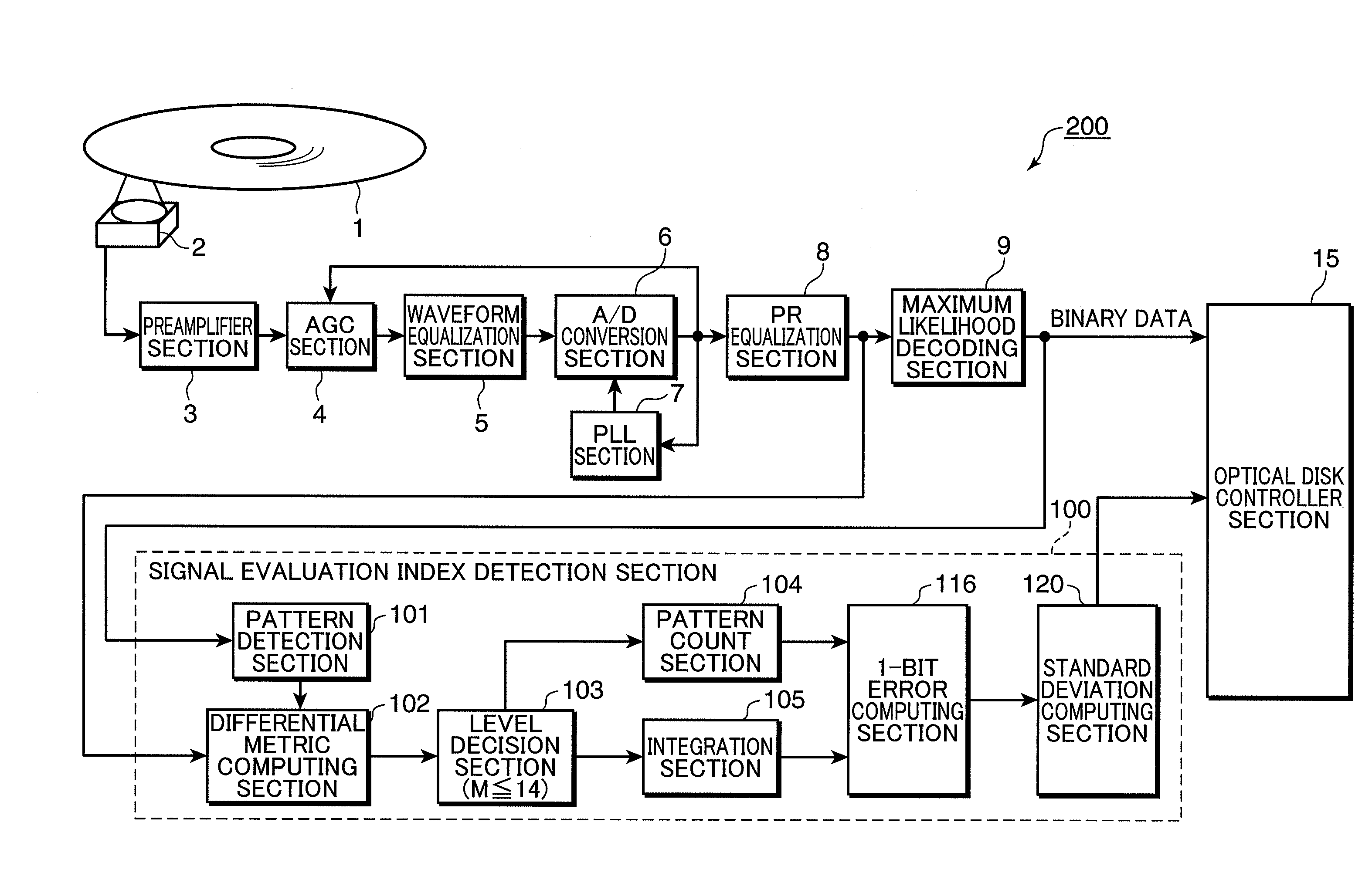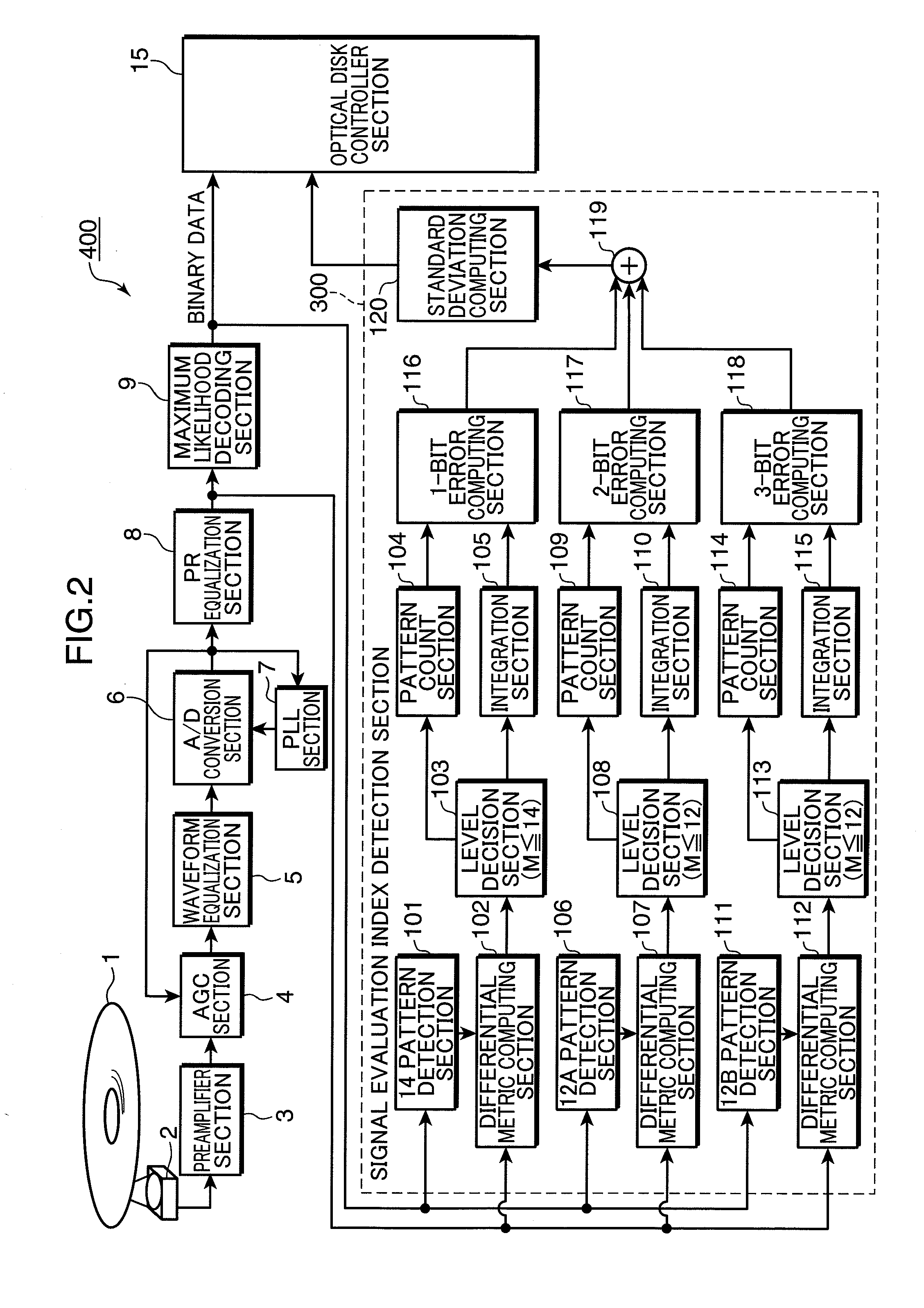Reproduction signal evaluation method, reproduction signal evaluation unit, and optical disk device adopting the same
a reproduction signal and evaluation method technology, applied in the direction of digital signal error detection/correction, amplitude demodulation, instruments, etc., can solve the problems of generating some problems in the reproduction signal evaluation method, increasing inter-symbol interference and signal noise ratio, and high correlation with the error rate. , the effect of high accuracy
- Summary
- Abstract
- Description
- Claims
- Application Information
AI Technical Summary
Benefits of technology
Problems solved by technology
Method used
Image
Examples
first embodiment
[0070]An optical disk device having a reproduction signal evaluation unit according to one embodiment of the present invention will now be described with reference to the drawings. FIG. 1 is a block diagram depicting a structure of the optical disk device 200 according to the first embodiment.
[0071]An information recording medium 1 is an information recording medium for optically recording / reproducing information, and is an optical disk medium, for example. The optical disk device 200 is a reproduction unit which reproduces information from the installed information recording medium 1.
[0072]The optical disk device 200 has an optical head section 2, a preamplifier section 3, an AGC (Automatic Gain Controller) section 4, a waveform equalization section 5, an A / D conversion section 6, a PLL (Phase Locked Loop) section 7, a PR equalization section 8, a maximum likelihood decoding section 9, a signal evaluation index detection section (reproduction signal evaluation unit) 100, and an opt...
second embodiment
[0103]An optical disk device having a reproduction signal evaluation unit according to another embodiment of the present invention will now be described with reference to the drawings. A composing element the same as the first embodiment is denoted with a same element number, for which description can be omitted. FIG. 2 is a block diagram depicting the structure of the optical disk device 400 of second embodiment.
[0104]An information recording medium 1 is an information recording medium for optically recording / reproducing information, and is an optical disk medium, for example. The optical disk device 400 is a reproduction unit which reproduces information from the installed information recording medium 1.
[0105]The optical disk device 400 has an optical head section 2, a pre-amplifier section 3, an AGC (Automatic Gain Controller) section 4, a waveform equalization section 5, an A / D conversion section 6, a PLL (Phase Locked Loop) section 7, a PR equalization section 8, a maximum like...
third embodiment
[0138]An optical disk device according to still another embodiment of the present invention will now be described with reference to the drawings.
[0139]FIG. 13 is a block diagram depicting a general structure of the optical disk device of the present embodiment.
[0140]The optical disk device 600 has: an optical head section 2, a pre-amplifier section 3, an AGC (Automatic Gain Controller) section 4, a waveform equalization section 5, an A / D conversion section 6, a PLL (Phase Locked Loop) section 7, a PR equalization section 8, a maximum likelihood decoding section 9, a signal evaluation index detection section (reproduction signal evaluation unit) 500 and an optical disk controller section 15. The structures and functions of these composing elements constituting the optical disk device 600 are the same as the first embodiment, and descriptions thereof are omitted here.
[0141]The optical disk device 600 according to the present embodiment has a signal evaluation index detection section 5...
PUM
| Property | Measurement | Unit |
|---|---|---|
| diameter | aaaaa | aaaaa |
| wavelength | aaaaa | aaaaa |
| wavelength | aaaaa | aaaaa |
Abstract
Description
Claims
Application Information
 Login to View More
Login to View More - R&D
- Intellectual Property
- Life Sciences
- Materials
- Tech Scout
- Unparalleled Data Quality
- Higher Quality Content
- 60% Fewer Hallucinations
Browse by: Latest US Patents, China's latest patents, Technical Efficacy Thesaurus, Application Domain, Technology Topic, Popular Technical Reports.
© 2025 PatSnap. All rights reserved.Legal|Privacy policy|Modern Slavery Act Transparency Statement|Sitemap|About US| Contact US: help@patsnap.com



